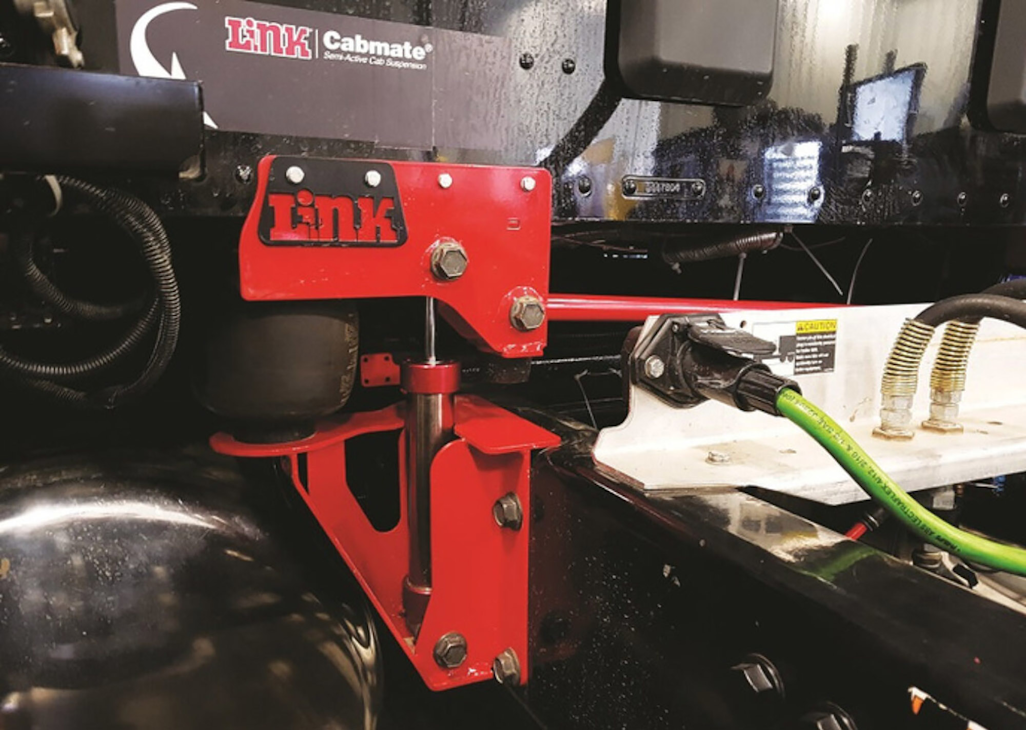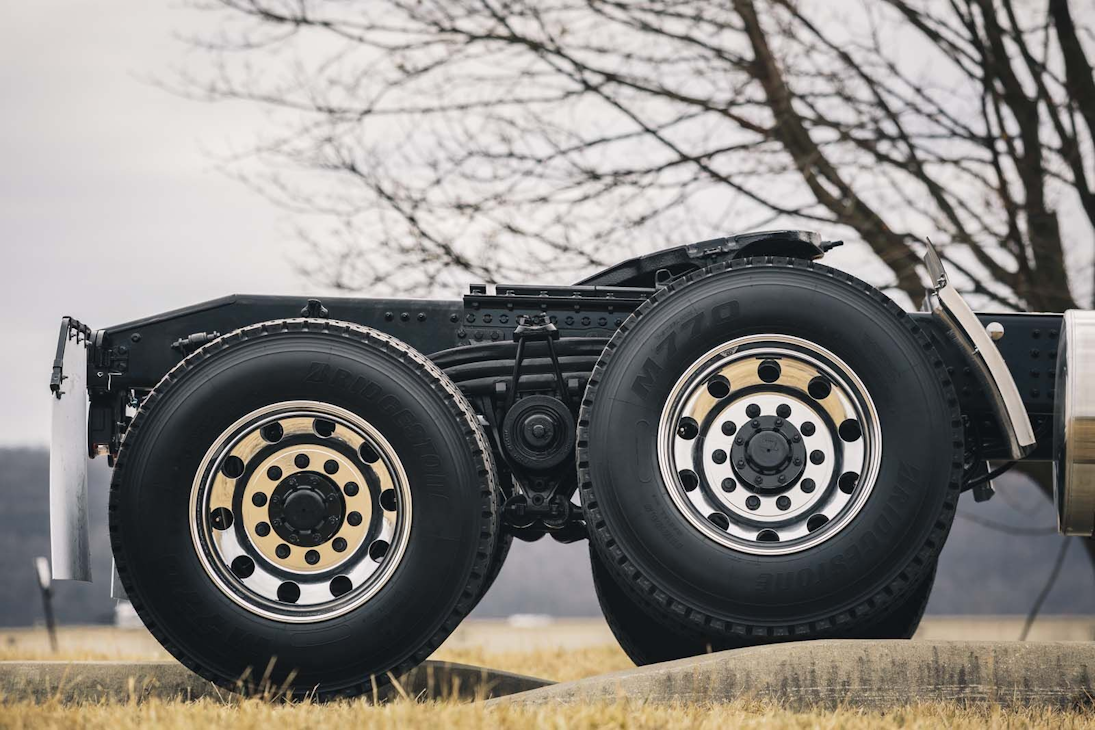Sensor-driven innovations in steering and suspension buffer drivers from rough road better than ever.
Previously, we covered the importance of maintaining steering and suspension systems, along with how noise, vibration, and harshness (NVH) can add to driver fatigue. Active steering technology, which adds an electric motor to the steering gear, is another way to combat driver fatigue, explained Ashley Murickan, product manager for Volvo Trucks North America.
“Volvo Dynamic Steering helps the driver control steering more easily, maintain directional stability at all speeds, and suppress road noise,” Murickan said. “In turn, this supports driver stamina by lessening the steering force, reducing vibrations, and providing better driver ergonomics.”
The solution also aids in safety. The Lane Keeping Assist feature also “gently” corrects for any drifting of the truck from the center of the lane. The Stability Assist feature enacts counter steering efforts to mitigate skidding events, guiding the steering torque and getting the Electronic Stability Control system to activate more quickly.
Volvo studies indicate that driving causes pain in 82% of truckers, with 63% visiting a doctor to manage that pain. VDS, which launched in Europe in 2013 and North America in 2019, can reduce muscle strain 30% to 70%, according to the truck maker.
“Active steering benefits include reducing wear and tear on the tires, axles, and suspensions of the tractor and trailer over time,” Murickan said. “This is due to the benefits of its software features, like the dampening of vibrations, lead pull compensation, and stability control.”
The system also provides steering benefits in a number of applications.
“VDS is ideal for diverse and changing terrains and automatically adjusts to handle any roadway condition,” Murickan added. “From rough roads to tight maneuvers in urban environments, VDS can help drivers navigate unexpected situations such as potholes and rapid tire deflations or strong side winds, providing up to 9 ft.-lbs. of torque in the steering column.”
If the electric motor or system were to fail, the conventional steering system, aided by hydraulic power, kicks in. Fault codes are sent to the driver, and repairs should be made by an authorized Volvo Trucks dealer. Anytime an alignment is performed, or the steering column gets removed, the system does require calibration with a Bendix ACom diagnostics tool.
Mack Trucks, also owned by the Volvo Group, has a similar solution called Command Steer for Anthem and Granite models. The assistive technology reduces the effort to turn a wheel by 85%, according to Mack. The sensors also collect 2,000 pieces of data per second to help the system react.
“If you have a blowout, rather than all of a sudden your steering wheel normally turning to one side, [Command Steer] actually holds the truck steady,” said Stu Russoli, highway product manager at Mack. “The truck is not going in the other lane and hitting another car, or go off the road.”
The system also can prevent rollovers.
“Most rollovers occur when a driver slightly drifts out of the lane. Then the tire kind of dips down on the road grade, and that pulls the whole vehicle in that direction,” said Tim Wrinkle, product manager for construction equipment at Mack. “Command Steer takes that pull a driver would experience and takes that out of the equation.”
Electronics-assisted suspension
Suspensions also are benefiting from the addition of smart technology. In 2019, Link Manufacturing introduced the Road-Optimized Innovations (ROI) Cabmate Semi-Active Cab Suspension for a smoother ride. ROI Cabmate uses sensors to assess the environment, speed, and relative position of the cab to the frame. Algorithms in the electronic control unit then alter the shock absorber stiffness in real time to nullify road inputs such as bumps or potholes. The system also stabilizes the cab from sidewinds.
Mark Molitor, Link’s senior product manager, pointed out that unlike seat stabilizer systems, the entire cab, including the team driver trying to get some sleep, benefits from the ROI’s continuous adjustments. He knew the system was a success when he heard that it passed one driver’s “visor test.”
“There are certain areas of highways that the driver had to keep putting his visor back up because it vibrates down, which is kind of annoying,” Molitor explained. “He’s been testing our ROI, and he said the one way he knows for sure that it’s working well is that when he goes down that strip of highway, his visor stays in place. He’s not getting that annoying vibration into his body the whole day.”
Link will roll out 8K, 10K, 13.5K, and 20K ROI Auxiliary Suspension Systems this year.
Smoother ride on a rocky road
For vocational fleets, spec’ing a suspension that can stand up the daily rigors of the worksite is key to keeping drivers in seats…literally.
“If you don’t have the right suspension, it’s going to bounce you out of the chair, and you’ll hit your head on the ceiling,” offered Tim Wrinkle, Mack Trucks product manager, construction, talking about drivers traversing an uneven work site.
Wrinkle explained a driver would likely have to creep along to prevent this, extending the time it takes to move across a job site. That lowers productivity and increases driver frustration. The fix for a smoother ride is usually opting for an air ride suspension, which cushion the kinetic energy from the ground with air bags. Air is provided directly by the compressor, or via a secondary air tank on the trailer. The extra complexity of these system increases cost and maintenance considerations.
Wrinkle said another trade-off is less traction for vocational trucks with air ride, which for some extreme duty cycles is more necessary than comfort.
“It’s all for naught if you get stuck, and you lose a couple hours of time because a bulldozer has to come. free your dump truck,” Wrinkle said.
He said the Mack mRIDE provides a balanced alternative. The system uses parabolic springs for strength and flexibility. The tires articulate 15 inches in either direction, allowing them to always contact the ground.
Trailer spec’ing
Deciding on air or spring ride really depends on the duty cycle and if the suspension will go on a dry van or specialty trailer.
Some fleets, such as Schneider, swear by mechanical spring for lower upfront costs and maintenance. After pitting a leading spring-ride suspenseful against four air ride counterparts, Schneider concluded: “Air ride does not guarantee greater ride quality than spring. It’s a myth. Knowing this, Schneider can’t justify spending more on air ride and recommends shippers don’t, either.”
A key factor was air bags’ vulnerability to damage and thus potential for unplanned downtime.
But that study was done more than 20 years ago, and there’s plenty of nuance to finding the right type of suspension.
For example, Hendrickson offers more than two dozen different trailer suspensions, and more for the tractor. To help spec the proper trailer suspension, the company offers the comprehensive L707 Application Guide.
But a chart won’t tell you everything. Don Hester, senior program manager of sliders and suspensions at Hendrickson, encourages customers to ask the right questions and not stop until they receive answers they are comfortable with.
These include asking about bridge laws in operating regions, what type of axles will best serve the application (tandem or tri-axle), and should you install a lift axle?
The type of trailer and duty cycle will help point a fleet in the right direction. According to Bill Hicks, product manager, trailer suspension and axle systems, at SAF-Holland, “On-highway dry freight vans have seen a shift towards the mechanical spring ride tandem sliders, which are now the majority rather than air ride systems.
“For specialty trailers like tanks, flatbeds, bulk, etc., the air ride is the system of choice, which can be traced to the overall value of the trailer and the expected longer service life,” Hicks continued.
Hicks’ colleague at SAF, Bryan Redeker, product manager, powered vehicle systems, also lauded air ride for the driver benefits.
“Air ride is unsurpassed when it comes to providing the comfort drivers need to avoid fatigue issues, Redeker said. “High-performance air ride suspensions not only enhance the ride comfort, but they also exhibit superior roll stability, especially when carrying high center of gravity loads over uneven terrain, and while cornering.”
That doesn’t mean spring ride should be bounced form consideration.
These mechanical suspensions can also last the life of the trailer, while they are “also typically less expensive and lighter than air ride suspensions,” noted Dan Cordier, VP of sales at Hutchens Industries. “They are easy to maintain and have a lower total cost of ownership, reducing the fleets downtime and maintenance expenses.”
Cordier concurred that for applications such as car haulers, dry bulk tanks, and wide axle base flatbed trailers would be better off with air ride.
With all these differing opinions, a sound strategy would be to involve both the drivers and maintenance departments and find a compromise everyone can live with.
by John Hitch
Source: https://www.fleetmaintenance.com/








